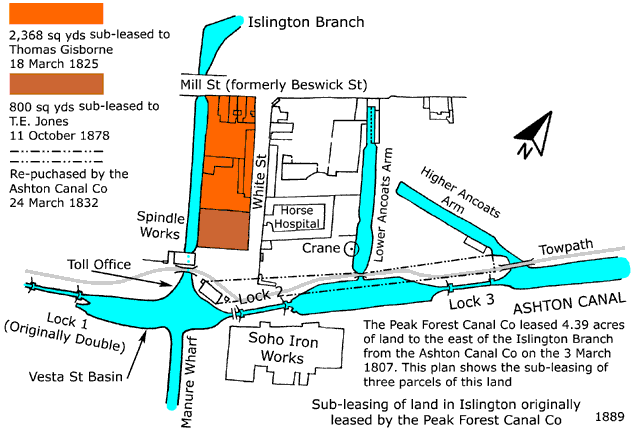
The Islington Branch of the Ashton Canal, in the heart of Ancoats, Manchester, was one of the most heavily industrialised sections of the Ashton Canal. With a length of 18 chains, it was the shortest of the branches of the Ashton Canal and it left the mainline between locks 1 and 2 at a distance of 29 chains from the start of the Ashton Canal at Rochdale Canal Junction, Ducie Street, Piccadilly.
To illustrate the number of firms occupying the wharfs of the Islington Branch, the table below is an extract from the Distance Tables of the Manchester, Sheffield and Lincolnshire Railway Company, dated Sep 1888. This railway company then owned the Ashton Canal.
CW = Company Wharf
| Distance from the Ashton Canal near Pollard St, Ancoats | Chains |
|---|---|
| Side Bridge over Branch. | 1 |
| E. Cotton & Co's Spindle Works. | 2 |
| John Mycroft's Wharf. | 3 |
| CW: Astley and Tyldesley Coal and Salt Co's Wharf. | 5 |
| Mill Street Bridge. | 6 |
| CW: W. O. Cunliffe's Scrap Iron Wharf. | 7 |
| John Sidebottom's Sun Mill. | 7 |
| Hall's Coal Wharf. | 8 |
| Hill's Sand Wharf. | 9 |
| 10 | |
| Cronshaw's Wharf. | 10 |
| Johnson, Clapham & Morris' Wire Works. | 10 |
| Jas. Dean's Wharf. | 11 |
| T. Crabtree's Dye Works. | 14 |
| John Port's Bedstead and Safe Works. | 15 |
| Hancock's Wharf. | 16 |
| Molineux, Webb & Co's Glassworks. | 18 |
On the map below, the four brown circles represent glass cones of Molineux, Webb & Co's Glassworks (also spelt Molineaux) situated at the head of the Islington Branch, known as Glassworks Basin. These brick-built cones, which could be up to 100-feet high, enclosed a furnace around which the glassmakers worked. By means of underground tunnels, air was drawn into the furnace to ensure that the high temperatures needed for glass making were achieved.
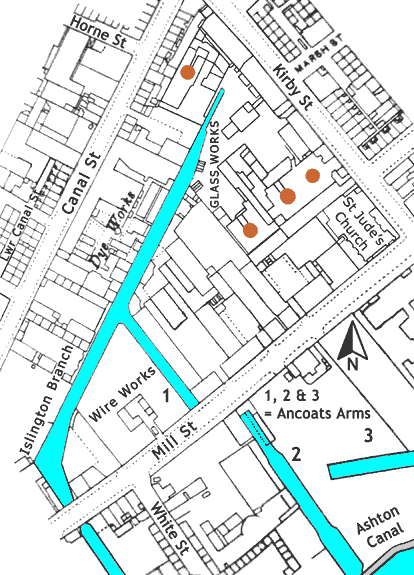
Islington Branch Canal, 1893.
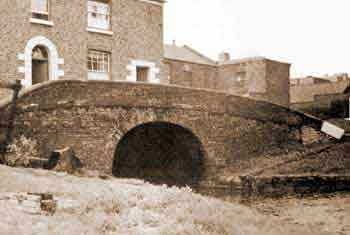 |
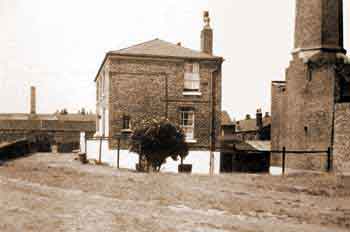 |
| The side bridge on the Ashton Canal over the entrance to the Islington Branch, 1960s.
The cottage (no longer extant) is built over the Islington Branch and Lock 2 is off the picture to the right. The bridge is listed Grade II, List Entry No. 1197830. |
View of the east elevation of the cottage over the Islington Branch with the side bridge to the left, 1960s. |
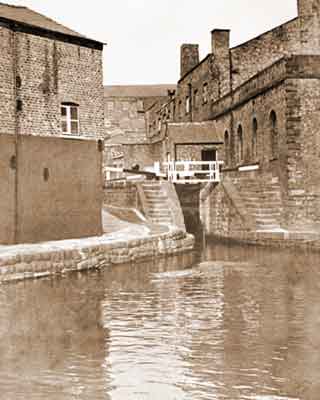 |
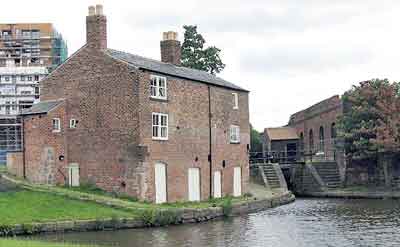 |
Lock 2, 1974. The building on the left was the lock-keeper’s cottage/toll office and the entrance to the Islington Branch is off the picture to the left. The Star Iron Works of Peel, Williams & Peel is to the right of the lock. The lock is listed Grade II, List Entry No. 1207654 and the cottage is listed Grade II, List Entry No. 1279636. |
The lock-keeper’s cottage/toll office, now altered since 1974, beside Lock 2. The entrance to the Islington Branch and side bridge are off the picture to the left. The remains of the Star Iron Works of Peel, Williams & Peel are to the right of the lock. |
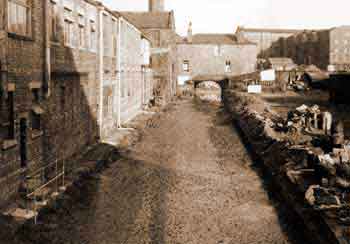 |
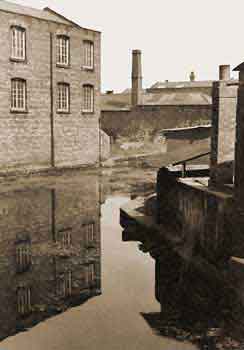 |
View looking along the Islington Branch towards the cottage built over it at the entrance, 1960s. View from Mill Street Bridge. |
View looking along the Islington Branch towards the head of the branch, 1960s. View from Mill Street Bridge. |
Land in Islington, Ancoats, leased by the Peak Forest Canal Co from the Ashton Canal Co
In February 1802 two members of the Committee of the Peak Forest Canal Co inspected land adjoining the Ashton Canal with the view of establishing company wharfs on it. They settled on a site to the north of the canal in the
vicinity of locks 2 and 3. The western boundary was the Islington Branch and the northern boundary was Mill Street. To begin with, a number of shareholders of the Peak Forest Canal Co leased a 4.39-acre site until the
company had gained the necessary powers and finances. The company eventually took control on the 3 March 1807. Company expectations for this venture were not realised and over a period of years the land was sub-leased to
other tenants. The disposal of this land was complex and the plan below shows how three parcels of land were disposed of.
The Higher Canal Arm was the first to be constructed. It was above the level of the surrounding land and its containing walls were supported by substantial buttresses to withstand water pressure. In c.1804 an office and weighbridge were provided by the Higher Arm and the Manchester agent of the Peak Forest Canal Co occupied the upper floor. Originally, the towpath of the Ashton Canal crossed the entrance to this arm on a wooden turn bridge, which was subsequently replaced by a fixed bridge. The Lower Ancoats Arm was constructed in c.1835 and it could accommodate up to eight boats. A transhipment warehouse was built at the head of this arm, on the eastern side, with a canopy over the canal to cover one boat.
In the early 1930s some of this land was used for an extension to Ancoats Hospital and consequently the Higher Ancoats Arm and about half of the Lower Ancoats Arm were filled in. Subsequently the remainder of the Lower Arm was filled in.
Sometime after the Manchester, Sheffield and Lincolnshire Railway Co had taken control of the Ashton Canal Co they built a horse hospital on the eastern side of White Street and this is shown on the plan of 1889.
